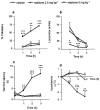Antiinflammatory action of endocannabinoid palmitoylethanolamide and the synthetic cannabinoid nabilone in a model of acute inflammation in the rat
- PMID: 11786493
- PMCID: PMC1573125
- DOI: 10.1038/sj.bjp.0704466
Antiinflammatory action of endocannabinoid palmitoylethanolamide and the synthetic cannabinoid nabilone in a model of acute inflammation in the rat
Abstract
1. The antiinflammatory activity of synthetic cannabinoid nabilone in the rat model of carrageenan-induced acute hindpaw inflammation was compared with that of the endocannabinoid palmitoylethanolamide and the nonsteroidal antiinflammatory drug indomethacin. 2. Preliminary experiments in rats used a tetrad of behavioural tests, specific for tetrahydrocannabinol-type activity in the CNS. These showed that the oral dose of nabilone 2.5 mg kg(-1) had no cannabinoid psychoactivity. 3. Intraplantar injection of carrageenan (1% w v(-1)) elicited a time-dependent increase in paw volume and thermal hyperalgesia. 4. Nabilone (0.75, 1.5, 2.5 mg kg(-1), p.o.), given 1 h before carrageenan, reduced the development of oedema and the associated hyperalgesia in a dose-related manner. Nabilone 2.5 mg kg(-1), palmitoylethanolamide 10 mg kg(-1) and indomethacin 5 mg kg(-1), given p.o. 1 h before carrageenan, also reduced the inflammatory parameters in a time-dependent manner. 5. The selective CB(2) cannabinoid receptor antagonist [N-[(1S)-endo-1,3,3-trimethyl bicyclo [2.2.1]heptan-2-yl]-5-(4-chloro-3-methylphenyl)-1-(4-methylbenzyl)pyrazole-3 carboxamide] (SR 144528), 3 mg kg(-1) p.o. 1 h before nabilone and palmitoylethanolamide, prevented the anti-oedema and antihyperalgesic effects of the two cannabinoid agonists 3 h after carrageenan. 6. Our findings show the antiinflammatory effect of nabilone and confirm that of palmitoylethanolamide indicating that these actions are mediated by an uncharacterized CB(2)-like cannabinoid receptor.
Figures





References
-
- AL-HABOUBI H.A., ZEITLIN I.J. Re-appraisal of the role of histamine in carrageenan-induced paw edema. Eur. J. Pharmacol. 1983;88:169–176. - PubMed
-
- ALOE L., LEON A., LEVI-MONTALCINI R. A proposed autacoid mechanism controlling mastocyte behaviour. Agents Action. 1993;39:C145–C147. - PubMed
-
- BENVENUTI F., LATTANZI F., DE GORI A., TARLI P. Attività di alcuni derivati della palmitoiletanolamide sull'edema da carragenina nella zampa di ratto. Boll. Soc. Ital. Biol. Sper. 1968;44:809–813. - PubMed
-
- BURSTEIN S.H., AUDETTE C.A., BREUER A., DEVANE W.A., COLODNER S., DOYLE S.A., MECHOULAM R. Synthetic nonpsychotropic cannabinoids with potent antiinflammatory, analgesic and leukocyte antiadhesion activities. J. Med. Chem. 1992;35:3135–3141. - PubMed
-
- BURSTEIN S.H., AUDETTE C.A., DOYLE S.A., HULL K., HUNTER S.A., LATHAM V. Antagonism to the actions of platelet activating factor by a nonpsychoactive cannabinoid. J. Pharmacol. Exp. Ther. 1989;251:531–535. - PubMed
Publication types
MeSH terms
Substances
LinkOut - more resources
Full Text Sources
Other Literature Sources
Research Materials

